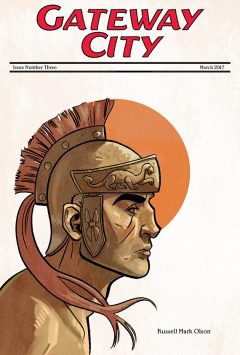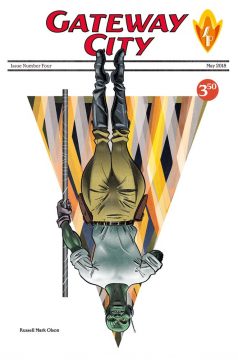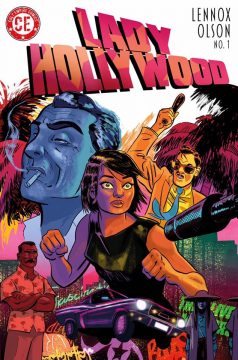“Most traditional genres have become too predictable, and the only way to keep them fresh is to whack them with a mallet” Russell Olson talks crime/noir sci-fi mash ups in Gateway City
 With it’s mix of classic old school crime noir and golden age sci-fi silliness, Russell Olson’s Gateway City has been one of our favourite discoveries of the year. With the latest issue in the bag and a new collected edition on the way, we catch up with the man behind it all, to find out why he wanted to mix things up with a whole new way of looking at the world of science fiction and crime noir!
With it’s mix of classic old school crime noir and golden age sci-fi silliness, Russell Olson’s Gateway City has been one of our favourite discoveries of the year. With the latest issue in the bag and a new collected edition on the way, we catch up with the man behind it all, to find out why he wanted to mix things up with a whole new way of looking at the world of science fiction and crime noir!
 Tell us a bit about the inspiration for Gateway City – was it crime noir first and how did the sci-fi elements come into play?
Tell us a bit about the inspiration for Gateway City – was it crime noir first and how did the sci-fi elements come into play?
Russell Mark Olson: Gateway City, or what became Gateway City, started somewhere around 2008 in the wake of the global financial crash. It was originally designed to be a Sunday-Funny-style strip a la Winsor McCay’s Little Nemo in Slumberland. It was set during the Great Depression and starred Sam, the little roach-like character, and a down-on-his-luck character called Fast-Fingered Freddie. Freddie more or less froze to death in the first comic, which led to a dying hallucination of Sam inviting him to come to the Afterland. I drew a handful of strips and plotted out two sketchbooks worth of stories, but I didn’t really have a plot per se. It was just Sam and Freddie getting into scrapes and escaping while looking for the missing architect of Afterland. Then, a couple of years later, I picked up some of IDW’s reprints of Chester Gould’s Dick Tracy and became obsessed. From doodling gangsters, I decided to try to draw a noir story…except that my rogue’s gallery sketches always turned out to look more like aliens. Instead of fighting it, I embraced it. It seemed like other books, especially the Lovecraftian ones were doing just fine blending genres, so I figured I’d just go with it. I started out improvising a couple of issues before scrapping it altogether and starting over with what is currently in print.
 Were you ever worried that the mix of genres might confuse or put off potential readers?
Were you ever worried that the mix of genres might confuse or put off potential readers?
RMO: Not really, to be honest. I figured there must be a similar cross-section of folks like myself who grew up with 80s sci-fi films and watching our dad’s 40’s-50’s noir films. I think one of the things that makes James Gunn’s GOTG films so beloved is that they blend in lots of other film tropes, like Indiana Jones, Seven Samurai/Magnificent Seven, Breakfast Club…When we were kids, there were no obvious divisions between our He-Man, GI Joe, Transformers, Star Wars and Ninja Turtle toys. They would interact, go on adventures together, team up, annoy She-Ra and her pal Strawberry Shortcake. We are truly children of Postmodernism and we don’t recognize seams. In fact, I’d argue that most traditional genres have become too predictable, and the only way to keep them fresh is to whack them with a mallet.
What was it about St Louis that made you pick it for the location? Is that a city close to your heart or a city with a lot a rich history you wanted to explore?
RMO: St Louis has always been a magical place for me. I grew up in the small, rural town of Hillsboro, about a 45 minute drive from St Louis and my family would often travel up to the city on weekends to take in the many cultural offerings. It’s unique in that the Zoo, Art Museum, Science Center and History Museum are all free. I couldn’t tell you how many times I’ve walked the galleries of the Art Museum. As well as being a child’s playground, the city has a long and august history (for American cities, that is). From the Native American city of Cahokia on the Illinois-side of the Mississippi, to French explorers in the 1670s, becoming the starting point for American Pioneers in the 1800s and enjoying metropolitan power in the 20th century, the city has a deep and rich trough of characters and happenings to bewitch an over-imaginative kid.
 I’ve been in the UK nearly 10 years, and during that time, I’ve supported my love of St Louis by reading quite a bit about it. One book in particular, Egan’s Rats by Daniel Waugh, cemented St Louis as the location for what would become Gateway City. During the first half of the 20th Century, the city was plagued by a number of violent gangs which controlled not only the ebb and flow of booze, but local elections and to some extent, the law. Many of the gangsters who survived the city went on to become players in the rackets of Chicago and New York. One member of the Egan’s Rats, Fred Burke, was particularly deadly and quite possibly introduced the world to the tommy-gun wielding gangster when he took part in the Valentine’s Day Massacre.
I’ve been in the UK nearly 10 years, and during that time, I’ve supported my love of St Louis by reading quite a bit about it. One book in particular, Egan’s Rats by Daniel Waugh, cemented St Louis as the location for what would become Gateway City. During the first half of the 20th Century, the city was plagued by a number of violent gangs which controlled not only the ebb and flow of booze, but local elections and to some extent, the law. Many of the gangsters who survived the city went on to become players in the rackets of Chicago and New York. One member of the Egan’s Rats, Fred Burke, was particularly deadly and quite possibly introduced the world to the tommy-gun wielding gangster when he took part in the Valentine’s Day Massacre.
St Louis is also home to an incredibly evocative downtown filled with the earliest skyscrapers and Art Deco facades. It isn’t hard to imagine a caped crusader swinging from building to building. All in all, I wanted to roam its streets and plumb its history even if I was sitting in Portsmouth some 4,000 miles away.
You have a great eye for detail in the artwork, do you use a lot of reference material? And how do you make sure you get the historical elements just right?
RMO: Why thank you! I do use a ton of reference. I live under an ever-growing mound of books on all manner of subjects. Although I like using my imagination, for period work, I prefer to know what I’m drawing. It not only ensures that I stay clear of the tuts from eagle-eyed readers, but it also informs the story. For example, in the first issue I wanted to include a thrilling plane/car chase, but after reading about the type of planes available to common folk of the time, the mechanics just wouldn’t work for what I imagined. Now, I could have just said, “Phooey, I’ll do it like I please,” which would have been ok, but giving in to the reality of the machines that would have been used gave me a chance to create something more interesting, and allowed for our hero to use his knowledge to evade capture. In the end, I think the solution is far more satisfying.
 I try not to allow the research to keep me from working, though. It is easy to get caught down the rabbit-hole of searching for an elusive viewpoint or mechanical detail which prevents the work from getting done. What I aim for is to gather enough information to create a passable idiom of what I’m drawing. I’ve learned a lot from looking at Harvey Kurtzman’s war stories.
I try not to allow the research to keep me from working, though. It is easy to get caught down the rabbit-hole of searching for an elusive viewpoint or mechanical detail which prevents the work from getting done. What I aim for is to gather enough information to create a passable idiom of what I’m drawing. I’ve learned a lot from looking at Harvey Kurtzman’s war stories.
Do you enjoy drawing the more fantastical space elements or the more grounded crime elements the most? And are there particular challenges for each?
RMO: Oooh. That’s a tough one. I love drawing suits and hats and classic cars, but I also like drawing a damned ugly mug. One thing I’m not too keen on, is drawing overly complex machines and spaceships and stuff like that. I’m trying to base all of the sci-fi stuff in GC on art and architecture from the 30s and 40s…as though somehow the appearance of the aliens in the 20s inspired that art movements to come. So, I’ve been looking at loads of Deco stuff, lots of Futurism and the like. I suppose the balance for me is making the alien stuff foreign enough but in keeping with a modern noir palette. I guess the challenge is to make sure that there always exists a line, however thin or blurry, that delineates the fantasy from the historical.
Do you enjoy the challenges of doing everything yourself on Gateway? Would you ever let another writer work on the characters allowing you more time to draw?
RMO: Wearing all the hats can be fun, and I’ve learned a ton doing it…and have also gained a great appreciation for all the letterers and colorists out there. Oh, and flatters. As of the third issue, my wife, Emily, has been flatting pages for me so that I can keep on top of the various other projects I’ve always got on the go. It’s been great to see her develop. If anyone is in need of a flatter, give her a ring.
I’d love to bring other voices into the world, now. I think I’d always like to be in control of the spine of the story, but there are loads of side stories to tell and I think bringing on some other writers and possibly even artists would be really fun. I’d love to see a Pete and Papers side story by Nick Prolix or get Gustavo Vargas on a tale about a couple of alien hit-men. I wonder what Tony Esmond could do with the bar at Hop Alley?
We talked about influences in our previous interview, but were there different inspirations for Gateway compared to Lady Hollywood? And who inspires you from an artistic point of view?
RMO: In some ways, yes, certainly. I think the core group of artists who have shaped my work the most are Kurtzman, Caniff, Jack Davis and Alex Toth…er, could I add 20+? But for storytelling style, I’ve been allowing a lot of 70s-80s B movies to instruct me with Lady Hollywood. For Gateway City, I always go back to two films, Maltese Falcon and The Third Man. Cinematography doesn’t come better than Robert Krasker’s work in The Third Man. Every six months or so, I pop it on and sit with my sketchbook and jot down impressions. It’s a masterclass.
I’m also influenced by Dasheill Hammett. His Continental Op stories are everything you want in Hardboiled fiction. A sci-fi treatment of Red Harvest would be amazing.
I come from a fine art background, and heavily studied the German Expressionists (and surrounding artists). I love Egon Schiele and would one day like to be able to pull off his line work. George Grosz’s Ecce Homo has probably found it’s way into my work, as well.
 You seem to be getting lots of momentum at the moment with Gateway City finishing and Lady Hollywood starting, is this a case of hard work finally paying off?
You seem to be getting lots of momentum at the moment with Gateway City finishing and Lady Hollywood starting, is this a case of hard work finally paying off?
RMO: I think it’s probably a combination of hard work, luck, and the kindness of others. Folks like yourself taking time out to read and share my book are a huge part in getting it out there. I really don’t think there’s a better place to create indie press books right now than the UK. The support network is strong as anything, and it’s filled with people who genuinely love the art form and just want to see everyone succeed. It’s a beautiful thing and the big push behind my momentum. I just hope to be able to pay it all forward.
You’ve just completed the first arc, what’s next for the world of Gateway City? A collected volume? Spin offs
RMO: The next step for Lundy and the gang is a trade paperback. John Freeman has lent his editing talents to help polish the first four chapters. The plan is to add a few new scenes, fix a couple of things that I feel don’t really work and to hint at a couple of future storylines. My aim is to launch a Kickstarter for it in August. I’m also planning on inviting a few guests artists to come in and create some pin-ups, so hopefully, for those who may already have an issue or two, there’s enough new content to justify picking up the collected volume. I might also throw in some pages of earlier iterations.
The next arc will be a bit more episodic, the gang investigating happenings throughout the city and beyond, and dealing with the consequences of a world turned on its head. And it would be fantastic to get some other folks to come in and have a play, too. Busting at the seams, really, to get stuck in to more story. It’ll be a juggling game for the forseeable future, but I’d hate to have to put GC away right now. I love that world so much and can’t wait to share more of it.
You can pick up copies of Gateway City from Russell’s online store here.



October 9, 2025 @ 2:40 am
This is going to help so many people. Watch wontumi tv live sports today morning — Ghanaian TV with live sports, news, talk shows, and events. Stream in HD with low‑latency playback, schedules, and on‑demand highlights. Including today’s schedule, morning show and interviews.
December 21, 2025 @ 12:21 am
Auf der fantastischen Außenterrasse mit Blick auf den Yachthafen und das Meer
können Sie täglich ein köstliches Mittagessen à la Carte und den ganzen Tag über erfrischende Getränke genießen. Während
Ihres Aufenthalts können Sie eine Vielzahl von Magic SPA-Massagen und -Behandlungen sowie einen beheizten Innenpool mit Wasserdüsen genießen. Der Pool auf der Dachterrasse,
der Personen über 16 Jahren vorbehalten ist, ist der ideale Ort, um ruhige Momente unter der Sonne Madeiras zu genießen. Halten Sie bei einer Bootstour Ausschau nach Walen und Delfinen und genießen Sie bei einem Zwischenstopp in einer der zahlreichen Buchten die herrlichen Kontraste, die das Grün dieser wunderschönen Insel
mit dem Blau des Meeres bildet. Es befindet sich direkt am Kreuzfahrthafen in der Bucht von Funchal, nur fünf Minuten zu Fuß vom Stadtzentrum
und dem Mittelpunkt des gesellschaftlichen und kulturellen Lebens entfernt.
3 Pools, Tennis, Tischtennis oder Basketball kann dort gespielt werden
Überprüfe wichtige Informationen mit dem Anbieter der
Unterkunft. Rezeption am Wochenende 24 Stunden besetzt Sind die Hotelzimmer mit
einer Klimaanlage ausgestattet?
Auf Fragen wurde immer schnell und kompetent reagiert Sowohl Frühstück als auch
Abendessen an einem großen abwechslungsreichen Buffet serviert.
Im Pestana Casino Park Hotel & Casino wohnen Sie in der
Nähe vieler der wichtigsten Sehenswürdigkeiten von Funchal, darunter der Botanische Garten Madeira,
die Kathedrale von Funchal und das Museu da Quinta das Cruzes.
Beliebte lokale Restaurants wie das Taberna Ruel, das Londres und das Casal da Penha sind mit dem
Auto erreichbar. Eine Autovermietung, Wäschemöglichkeiten, Geschäfte und ein Businesscenter sorgen in der Unterkunft für zusätzlichen Komfort.
References:
https://online-spielhallen.de/plinko-casino-cashback-ihr-weg-zu-mehr-spielguthaben/